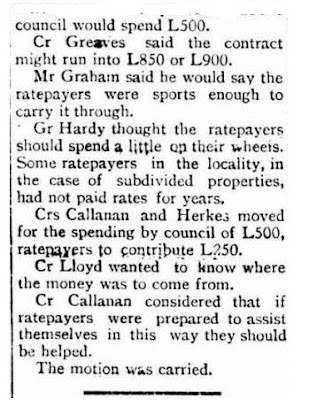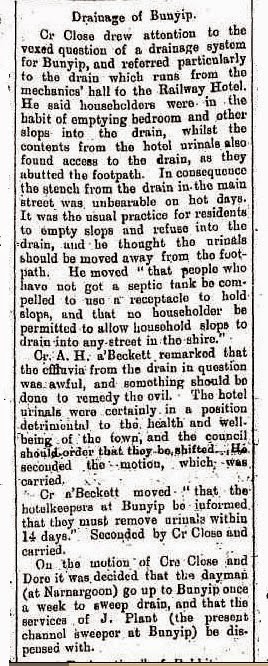St Joseph's Convent Iona opened one hundred years ago, on April 11, 1915. The Convent housed the Sisters of St Joseph, who established a school in Columba Hall (the Parish Hall) to provide the children with a sound secular and religious education. A report two weeks later said that three Sisters of St Joseph on the teaching staff and sixty children attend daily. (1) School continued in the Hall until it was destroyed by fire on December 26, 1927. A new brick hall (the existing hall), also used for the school, was opened October 21, 1928. A purpose built school was opened at Iona on November 26, 1961. (2)
Opening of the Convent School at Iona
New Convent School, Iona
The ceremony of the solemn blessing and opening of the new Convent of the Sisters of St. Joseph, Iona, was performed by His Grace the most Rev. Dr. Mannix on Sunday afternoon last. There was a very large attendance, including some from the outlaying parts of the parish, notwithstanding the inclemency of the weather.
The Rev. J. J. Malone, P.P., of Clifton Hill, gave an eloquent touching, and instructive address on the Religious Life at the 11 o'clock mass to a large congregation.
The contributions for the day amounted to nearly £400, while donations amounting to £246 had been previously received in response to a direct appeal to the parishioners.
The opening of the Convent in 1915
Image: 100 years of a Catholic Faith Community: St Joseph's Iona 1905-2005 by Damian Smith. (The Author, 2005)
A more detailed of this momentous event in Iona was reported in
The Advocate, of April 17, 1915 (see
here)
OPENING OR A NEW CONVENT AT IONA BY THIS COADJUTOR-ARCHBISHOP.
His Grace Archbishop Mannix opened a new convent at Iona on last Sunday. Notwithstanding the severity of the weather and the long distance many of them had to travel, most of the parishioners from Iona itself and the outlying districts assembled on the occasion. Between two lines of people which stretched from the gate of the presbytery to the door of the convent, his Grace walked, accompanied by the pastor, Fr. Cusack, and his assistant, Fr. Macnamara, Frs. Gleeson and O'Connor, of Essendon, Fr. Malone, of Clifton Hill, and Fr. O'Ryan, of West Melbourne. Thanks to a fortunate break in the weather, his Grace was enabled to address the large gathering from the presbytery verandah.
His Grace, in addressing the people, said that in consequence of the forthcoming meeting to be held in the Town Hall, Melbourne, on April 28th, he was prevented from discussing the new situation created by the recent decision of the Political Labour Council.
The convent itself, which was designed by Messrs. Kempson and Conolly, and erected and furnished at a cost of over £1100, is a commodious and elegant structure, worthy of the place and people, worthy of the pastor and his predecessor, who have done yeoman service in building up a very difficult mission, and worthy of the heroic Order of the Sisters of St. Joseph, who have undertaken the task of imparting a sound secular and religious education to the children. There was something stimulating in the enthusiasm and intense religious earnestness of the large gathering, which touched his Grace and thrilled his utterance.
From the balance-sheet, which was read by Fr. Cusack before his Grace's address, he could see, he said, that priest and people had done great work there for God and religion, and felt sure that whatever decision may be arrived at by the Town Hall meeting, the Catholics of Iona could be relied upon to adopt it whole-heartedly, and, when the time comes, put it into active execution. Judging by the generous donations received in response to the appeal made to them, Fr. Cusack should have no difficulty in wiping out the balance of the debt which lies on the mission. The contributions for the day amounted to £385, while donations of £246 had been previously received in response to a direct appeal to the parishioners. The fact that his Grace's visit was coincident with the break up of the drought opened their hearts more freely and forced them to put their hands deeper into their pockets.
Clearly, too, they appreciate the privilege of having a staff of self-sacrificing nuns in their midst to provide for the secular and religious training of their children. As one who revisited the place for the first time after a space of twenty years, I have only to add that I was astonished at its marvellous material progress and at the no less marvellous progress of its Catholicity.
The New Convent
The building is of wood, with Californian pine dado outside. The roof is of corrugated iron, walls of lath and plaster, ceiling of stamped metal, flooring of Queensland pine. The hall, front and back, is 6 feet wide. The oratory is 18ft. by 16ft.; refectory, 20 by 16; reception-room, 16 by 11; dormitory, 16 by 15½. Other rooms are 16 by 14. There is a verandah round the front and two sides, 6ft; wide. The building is well ventilated and lighted. The parish hall has been fitted up and renovated and furnished as a school in accordance with the requirements of the Board of Health.
The works have been carried out from designs and under the superintendence of Messrs. Kempson and Conolly, architects, Oxford Chambers, Bourke-street, Melbourne, by Mr. T. Bain, contractor, Coburg.
Footnotes
(1)
Bunyip Free Press, April 29, 1915, see
here.
(2)
The Age, December 27, 1927, see
here;
The Advocate, October 25, 1928, see
here; Smith, Damien,
100 years of a Catholic Faith Community: St Joseph's Iona 1905-2005 (The Author, 2005), p. 63.






























